
How ABBA Voyage was made
💬 Shini says...
Ingenia 100 guest editor Dr Shini Somara tells us her thoughts
The engineering steals the show here (or is as exciting as the show itself). I grew up listening to ABBA, so this article takes me right back to my childhood. What an incredible fusion of entertainment and advanced technology. And to think that the building is central to the show’s success, demonstrates how infrastructure often takes centre stage. This show has been a roaring success in London, but for me, engineers who make it happen, are the winners who take it all!
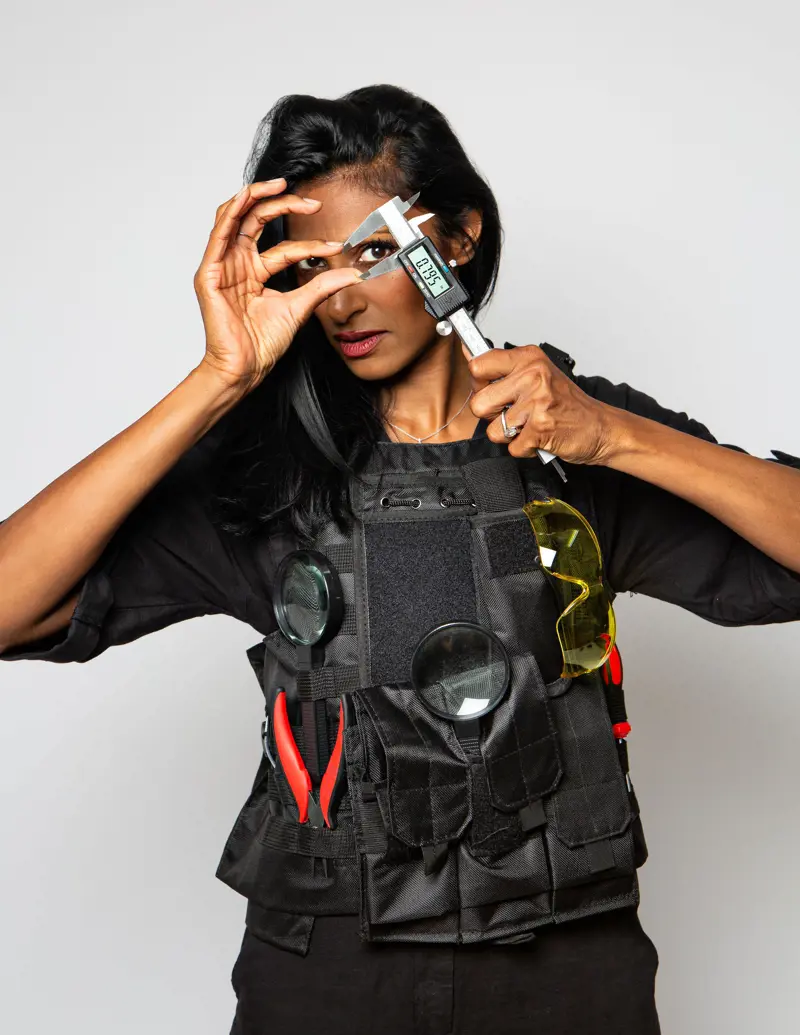
Seven times a week, 3,000 people, many fabulously garbed in the seventies’ finest fashions and adorned in sequins, arrive at Pudding Mill Lane station in East London. Their destination: a time machine. After entering the time machine, a hexagonal building more than 25 metres tall, they head to its bowl-shaped auditorium. There’s a sense of expectation hanging in the air.
Then the show begins. Live musicians play beyond a vast wall of screens that bring every one of those 3,000 audience members closer to the action. In front of those screens, four performers sing, dance and play through a set list of 22 greatest hits. The revellers can see and hear the performers, but they’re not actually there. Now in their seventies, the performers are hundreds of miles away.
This is ABBA Voyage, the immersive concert that has let millions experience see a facsimile of what the group looked like 45 years ago in their heyday. The show takes place in a ‘flat pack’ structure, thought to be the largest demountable concert venue in the world. When the party is over, everything can be packed into storage containers and shipped to another destination.
The project was the product of eight years of collaborative work of teams of engineers, architects, contractors, and thousands of visual artists based all over the world. Many of the project’s achievements were world firsts. So, how did they do it?
The first step was to faithfully replicate the unique way the band members moved to their songs, otherwise the illusion would be shattered.
You can dance, you can jive
The first step was to faithfully replicate the unique way the band members moved to their songs, otherwise the illusion would be shattered. “It’s like a fingerprint,” said show producer Svana Gisla in an interview at the Beyond Conference in November 2023.
So, for five weeks in the winter of 2020, the four members of ABBA – Agnetha Fältskog, Anni-Frid Lyngstad, Björn Ulvaeus, and Benny Andersson – reunited to perform every song to be included in the show in a motion capture studio in Stockholm. Show producer Ludvig Andersson (Benny’s son) described how 160 cameras captured “every mannerism, every emotion, the soul of their beings”. He added: “It is not a version of, or a copy of four people pretending to be ABBA, it is actually them.”
Behind the cameras were Industrial Light & Magic (ILM), the company that has provided visual effects for almost every big-screen spectacle you can think of, including Star Wars, Jurassic Park, and the Marvel Cinematic Universe movies. According to Gisla, ABBA Voyage was the biggest project the company had ever worked on, calling upon the skills of about 1,000 visual artists from four of its global studios. Ben Morris, ILM’s creative director, described the performance capture as “the basis for the whole of the project, the backbone”.
In a motion capture studio, performers wear special suits dotted with small spherical markers on particular positions on their bodies. These markers are covered in reflective tape, says Martin Parsons, creative lead at the University of Bath’s Centre for the Analysis of Motion, Entertainment Research and Applications (CAMERA). CAMERA uses motion capture for gait analysis in elite sports, and to drive the motion of characters in virtual reality scenes.
An array of cameras surrounds the performers, to identify and triangulate the markers in the 3D scene. To pick up the markers, the cameras can only ‘see’ black and white, and to replicate motion smoothly, they typically capture the action 120 times per second. The system is calibrated to understand where all the cameras are in relationship with each other, so it can work out where all the dots are in space, Parsons explains.
As a first step, the performers will make their own personalised ‘skeleton’ by performing a range of motion, Parsons says. The system, knowing where it expects to find the markers on the performer’s body and in relation to one another, fits a template to identify the markers. It can then create a digital skeleton to map onto a 3D animated model, or ‘asset’, to drive its movements.
After the motion capture, it was back to London, where choreographer Wayne McGregor got to work translating ABBA’s physical ‘fingerprints’ to a group of dancer body doubles. This would imbue the digital imprints of the original band members with their younger, 1979 energy. But it goes further than that: “It’s way more than choreography,” Gisla said. “It’s finding physicality and weight in people.”
She added: “It’s one thing creating an object, but to make that object crash or to make that person move, let alone dance and perform and stomp, and for that connection to the floor to ripple into the body… that DNA of movement.”
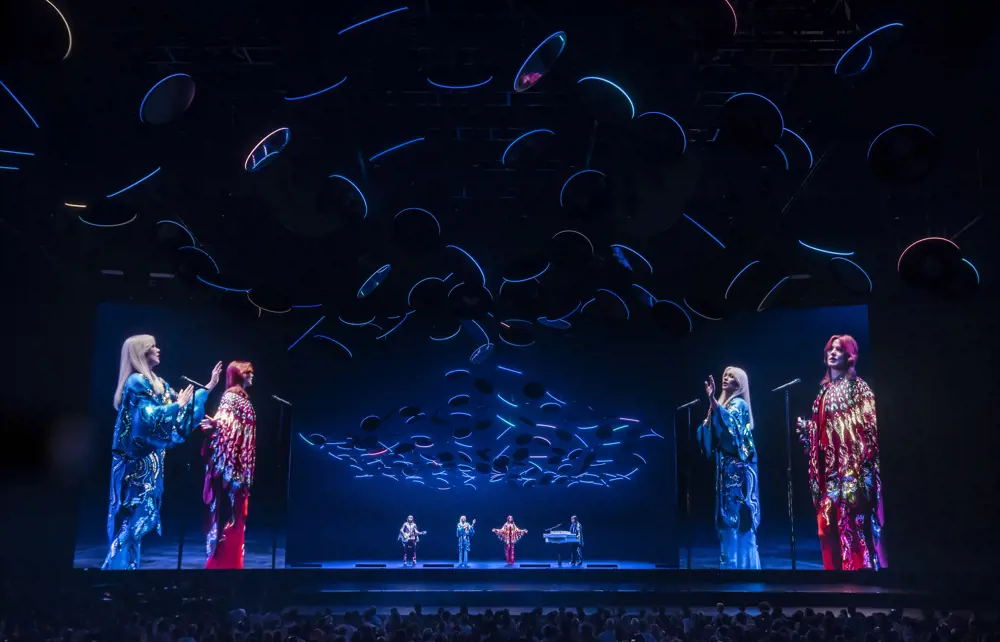
© Dirk Lindner, Stufish
The show’s producers wince if you call these so-called ABBAtars ‘holograms’. They’re not nebulous likenesses that look like they could fade away. They appear touchable, from their hair to their rhinestone-encrusted outfits.
Like many of the methods employed to create the show, exactly how ABBAtars are rendered on stage is a secret, though some commentators have suggested that like other so-called hologram concerts, they’re using a variation of an illusion called Pepper’s ghost.
In this parlour trick first seen in the 1860s, an angled pane of glass divides the stage into two areas – one that the audience can see and another that remains hidden. The hidden part of the stage contains the brightly lit performers, whose life-like reflection is seen by the audience on the angled glass. It works because glass becomes more reflective the darker the area behind it becomes – this is why you can use your phone screen as a makeshift mirror when it’s off, but not so much when it’s illuminated.
Three 65-million-pixel LED TV screens behind the virtual performers – the central one showing what’s happening on stage, the two flanking ones providing close ups of the band’s faces – seamlessly blend the physical and digital.
The final piece of the ABBAtars’ puzzle was, of course, their faces. But to capture the vast suite of expressions of the performers’ faces, motion capture’s markers can’t go far enough. Here, the effects rely on facial recognition techniques. In facial capture, head-focused cameras capture anchor points on the face, Parsons explains, as well as the texture of the skin. Similarly to motion capture, the information captured by the cameras is used to create facial maps that then drive digital assets. To Benny and Björn’s dismay, this process required that they shave their beards. “Is there no other way we can do this?” Bjorn recalled saying, in an interview about the process.
Now complete, the ABBAtars needed a space to perform. It would be an arena like no other.
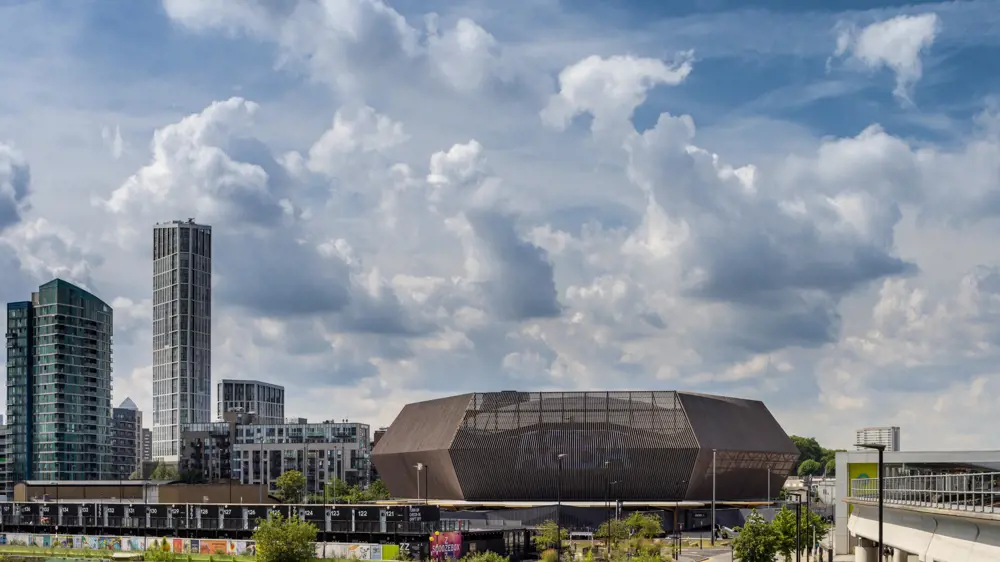
The Institute of Structural Engineers recognised the arena as a 2023 winner of its Structural Awards, for “celebrating modular, demountable timber at scale” © Dirk Lindner, Stufish
Masters of the scene
“With a typical design, the building comes first, and the show comes in second and fits into the building,” says Ewa Hazla, who was an engineering design lead on the project at structural engineering firm Atelier One. However, the very specific needs of this project required that the show and the venue were created in tandem.
Its ambitious requirements included the need to seamlessly blend the digital and physical on stage, including the lights, sound and other effects. It would have to ensure flawless sound quality inside, while not disturbing neighbours just 65 metres away. Finally, it had to be possible to disassemble and pack the show away – planned after ABBA Voyage completes its run in 2025. To pull this all off would take a highly coordinated effort between architects, engineers and contractors.
Atelier One worked with entertainment architects Stufish to develop the structure, its envelope and the front canopies. This was based on a lightweight steel skeleton covered with two layers of timber panels that provide thermal and acoustic insulation. Inside the building, cross-laminated timber (see box) panels make up areas for front-of-house, including bars, retail, cloakroom spaces, and the VIP lounge, as well as providing the finish. A rainscreen of 1,400 finger-jointed fins of larch, a naturally durable and waterproof timber, envelops its exterior.
Lightweight, cost-effective, and with lower embodied carbon than other building materials, timber was the star material of the arena.
Lightweight, cost-effective, and with lower embodied carbon than other building materials, timber was the star material of the arena. “Timber offered a better solution than any alternative material,” says Hazla. “We wanted to make an effort to incorporate as much timber into the project as possible.” Choosing cross-laminated timber also sped up the installation process, she explains, as once the panels were in place, the spaces were effectively complete – no additional finish required. “It eliminated use of materials that just don’t work for demountable design, like plasterboard, which can be damaged during assembly or transport, and would need to be replaced at the
next install.”
Inside the theatre, the design plays a substantial role in merging the digital and the physical. “It’s all about geometry,” Gisla explained. “It’s about sight lines, it’s about height, it’s about distances, it’s just math,” she said. “The stage has got be a certain distance from the screen, there’s got to be a rake [a stage that slopes upwards from front to back], the audience can’t be too high, they’ve got to be lower than the lights, there’s got to be multiple lighting, it’s all about geometry.”
Overall, it took about a year to assemble, although Hazla estimates that it will take half as long next time, and half as long again to disassemble. The need to eventually disassemble was a factor in every decision about design and materials. With traditional construction of permanent buildings, you only consider that first build, Hazla says: “You generally don’t consider how they would be taken away. In our case, every design decision, every detail, every material choice had to factor into not only how that element goes in, but also how does it come out.”
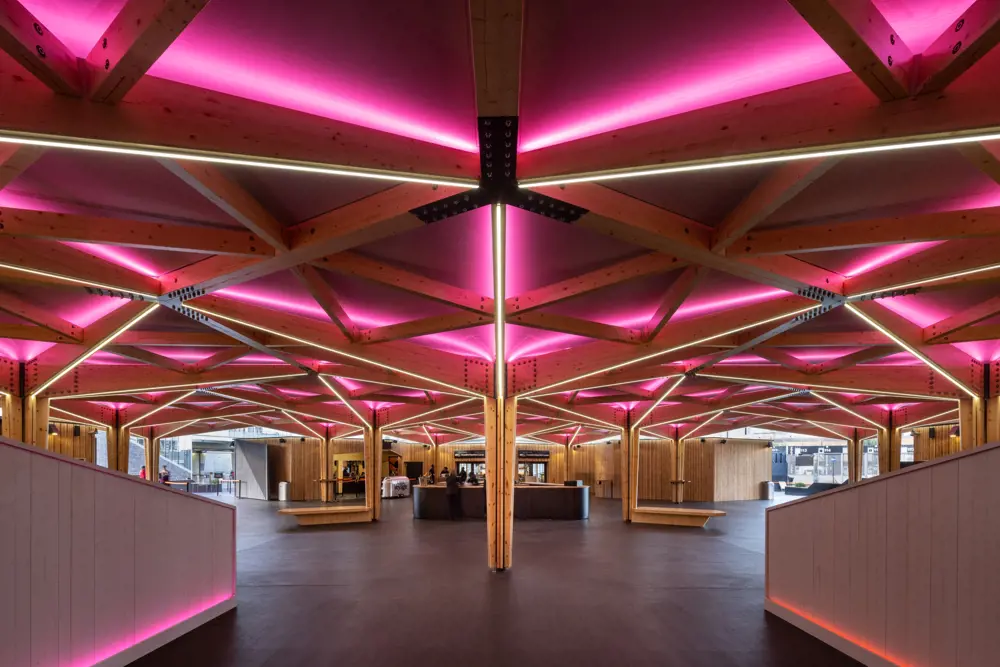
Timber was the star material of the arena, saving on the building’s embodied carbon emissions as no additional finish was needed © Dirk Lindner, Stufish
SOS: A guide to different terms and techniques
Cross-laminated timber: An engineered wood made of layers of timber glued together. “The alternating layers are at 90 degrees to one another in terms of the grain,” Hazla explains. “It means that you’ve got strength in both directions.”
Rainscreen: In construction, a rainscreen is a wall that sits away from the interior wall to stop too much water coming into contact with the building itself. This gap both provides a space for water to drain away, and ventilation to speed up the drying of any moisture. The ABBA Arena’s rainscreen, created by timber specialist Xylotek, was fire treated, stained, and incorporated an insect mesh.
Finger joint: A joint used to attach lengths of timber to create longer lengths. Several ‘fingers’ are cut from the end of each length and interlocked (much like how you’d interlace your straightened fingers), held in place by a glue. As each of the rainscreen fins had to reach four-storey heights, Xylotek made every one of the 1,400 individual lengths in Bristol before sending them to London in 204 panels. The total length of the fins is about 15 kilometres.
They also had to think about how robust the different components are, so that they will stand up to travel and repeated assembly. “Every single material choice, every single fixing and detail on this project had to be checked,” she adds.
Sound was another crucial consideration in the design of the building, requiring excellent sound quality, soundproofing and reduced noise in a light, robust structure. Working alongside Stufish and design and construction teams, acoustic consultants Charcoalblue developed a two-skin layer equipped with vibration isolators. Generally speaking, vibration isolators reduce unwanted noise by the use of springs or compressive mounts. This avoids rigid connections between the inner and outer skins, and improves the overall acoustic performance of the auditorium shell.
This acoustic layer extended to the building’s roof, which contains all the lighting, mirrors, loudspeakers, lasers, and smoke machines. (Hazla explains it is standard in such venues for show equipment to sit above the audience.)
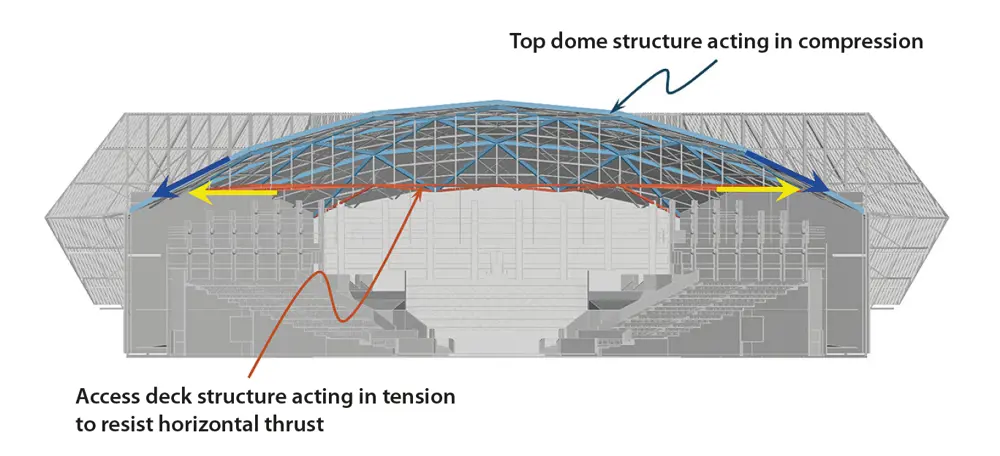
The tied dome structure creates a strong platform to bear the load of the show equipment in the roof © Atelier One
Sitting on top of the drum-like structure of the building’s external walls, the roof had to be as light as possible. Atelier One developed what is known as a tied dome structure, which provides an elegant solution to two problems: it both reduces the horizontal force of the roof on the walls of the arena and creates a strong platform to bear the load of the show equipment. “We explored many, many forms for the roof,” Hazla says, adding that the tied dome offered the most efficient way to span the distance with the least material.
The key is the horizontal ties, which pull inwards from the edges of the dome to hold it in place. The tension in these ties provides the strength for the platform. The same principle is at play with tied arch bridges.
The roof was built at ground level. This made loading the show equipment much more straightforward, not to mention safer as there was no need to work at height. It also meant that they could construct the roof at the same time as the perimeter structure, Hazla says.
Contractor ES Global raised the roof into place with lifting devices called strand jacks. These lift loads by the action of a hydraulic cylinder on a pair of clamps holding a bunch of cables – no need for cranes or heavy machinery. Strand jacks were attached to 18 points on the roof and the building’s primary columns to lift the 70 metre-wide, 750-tonne structure from ground level to crowning glory in a matter of days. “It was absolutely immense,” Hazla says.
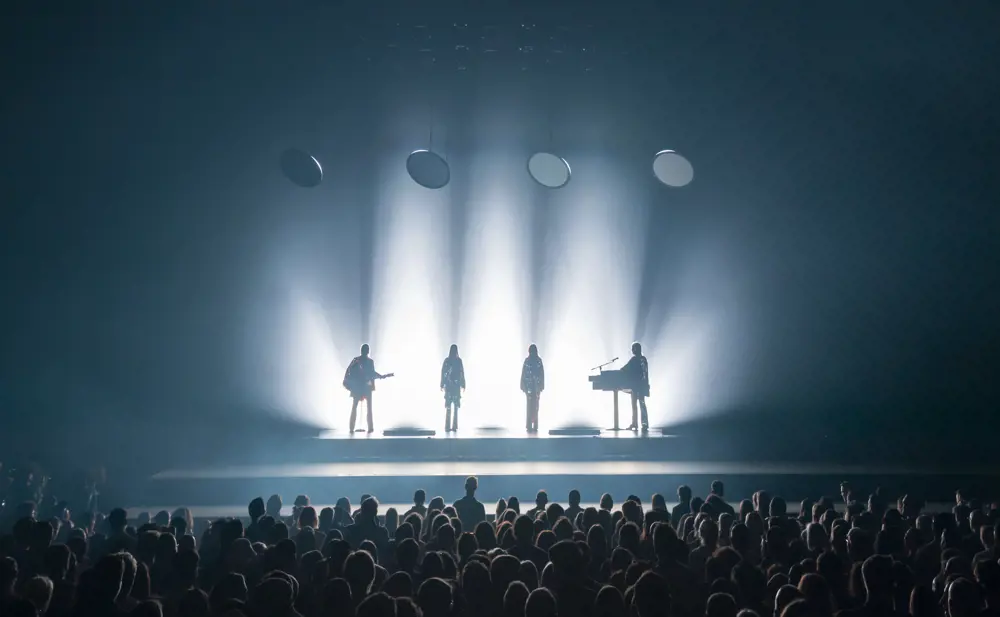
© Johan Perrson
Here I go again
At the time of writing, the show is due to play in London until May 2025 before heading to its next location, although Gisla has indicated the show might go on for longer (also hinting at the possibility of new arenas appearing in cities in North America and Oceania).
The building has more than enough life in it to support shows for years to come. It has no shorter lifespan than any permanent building, says Hazla. “From a structural perspective, the maintenance requirements have been very minimal,” she says, also noting that with the right maintenance and repair, it could last even longer than a typical permanent building.
Which is food for thought: if demountable buildings like these can offer the durability of more permanent structures while being less carbon-intensive, can they play a greater role in decarbonising the construction industry?
For Hazla, the answer is yes. “We should adopt this approach more ordinarily for permanent buildings, and consider reuse and what happens to the building at the end of its life right from the start,” says Hazla.
When the ABBA Voyage building does finally close for good, the site will be just as it always was before this time machine descended, allowing another structure to take its place, perhaps. After every last cross-laminated timber panel, screw, and lightbulb is packed away, it will leave without a trace. Except for the odd danced-off sequin, of course.
***
Behind the scenes in arts and culture:
🕷️ Building Glastonbury Festival's famous Arcadia spider
☔ Making it rain onstage at Singin' in the Rain
🖌️ The technologies that recreate historic paintings and artefacts
Contributors
Ewa Hazla ran the day-to-day structural engineering design of the project at Atelier One alongside Aran Chadwick, the company’s director, also working closely with principal contractor ES Global, acoustic consultants Charcoalblue, and project manager Gardiner & Theobald.
Martin Parsons, Creative Lead at the University of Bath’s Centre for the Analysis of Motion, Entertainment Research and Applications, is a fine art graduate and Emmy Award winner, with 30 years’ experience in visual effects. He is currently engaged in research into the future of computer-generated moving image technology.
Leonie Mercedes is a freelance writer based in London.
Keep up-to-date with Ingenia for free
SubscribeRelated content
Arts & culture
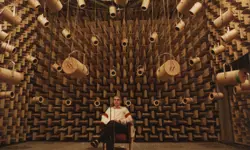
How to maximise loudspeaker quality
Ingenia asked Dr Jack Oclee-Brown, Head of Acoustics at KEF Audio, to outline the considerations that audio engineers need to make when developing high-quality speakers.

Engineering personality into robots
Robots that have personalities and interact with humans have long been the preserve of sci-fi films, although usually portrayed by actors in costumes or CGI. However, as the field of robotics develops, these robots are becoming real. Find out about the scene-stealing, real-life Star Wars droids.

Design-led innovation and sustainability
The Stavros Niarchos Foundation Cultural Center, the new home of the Greek National Opera and the Greek National Library, boasts an innovative, slender canopy that is the largest and most highly engineered ferrocement structure in the world.
The technology behind ‘The Tempest'
William Shakespeare’s The Tempest is a fantastical play that features illusion and otherworldly beings. Discover how cutting-edge technology, such as motion capture and sensors, has brought the magic and spectacle to life on stage.
Other content from Ingenia
Quick read

- Environment & sustainability
- Opinion
A young engineer’s perspective on the good, the bad and the ugly of COP27

- Environment & sustainability
- Issue 95
How do we pay for net zero technologies?
Quick read

- Transport
- Mechanical
- How I got here
Electrifying trains and STEMAZING outreach

- Civil & structural
- Environment & sustainability
- Issue 95